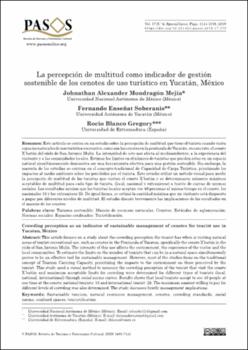La percepción de multitud como indicador de gestión sostenible de los cenotes de uso turístico en Yucatán, México
Date
2019Abstract
Este artículo se centra en un estudio sobre la percepción de multitud que tiene el turista cuando visita espacios naturales de uso turístico ‑recreativo, como son los cenotes en la península de Yucatán, en concreto, el cenote X ́batún del ejido de San Antonio Mulix. La intensidad de este uso afecta al medioambiente, a la experiencia del visitante y a las comunidades locales. Estimar los límites en el número de turistas que pueden estar en un espacio natural simultáneamente demuestra ser una herramienta efectiva para una gestión sostenible. Sin embargo, la mayoría de los estudios se centran en el concepto tradicional de Capacidad de Carga Turística, priorizando los impactos al medio ambiente sobre los percibidos por el turista. Este estudio utilizó un método visual para medir la percepción de multitud de los turistas que visitan el cenote X ́batún y se determinaron números máximos aceptables de multitud para cada tipo de turista, (local, nacional y extranjeros) a través de curvas de normas sociales. Los resultados arrojan que los turistas locales aceptan ver 40 personas al mismo tiempo en el cenote; los nacionales 33 y los extranjeros 28. De igual forma, se estimó la cantidad máxima que un visitante está dispuesto a pagar por diferentes niveles de multitud. El estudio discute brevemente las implicaciones de los resultados en el manejo de los cenotes. This article focuses on a study about the crowding perception the tourist has when is visiting natural areas of tourist ‑recreational use, such as cenotes in the Peninsula of Yucatan, specifically the cenote X’batún in the ejido of San Antonio Mulix. The intensity of this use affects the environment, the experience of the visitor and the local communities. To estimate the limits on the number of tourists that can be in a natural space simultaneously proves to be an effective tool for sustainable management. However, most of the studies focus on the traditional concept of Tourism Carrying Capacity, prioritizing the impacts to the environment on those perceived by the tourist. This study used a visual method to measure the crowding perception of the tourist that visit the cenote X ́batún and maximum acceptable limits for crowding were determined for different types of tourists (local, national, international) through social norms curves. Results shows that local tourists accept to see 40 people at one time at the cenote; national tourists: 33 and international tourist: 28. The maximum amount willing to pay for different levels of crowding was also determined. The study discusses briefly management implications.





